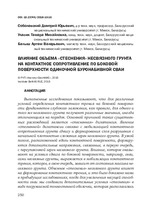| dc.contributor.author | Соболевский, Д. Ю. | ru |
| dc.contributor.author | Уласик, Т. М. | ru |
| dc.contributor.author | Балыш, А. В. | ru |
| dc.coverage.spatial | Минск | ru |
| dc.date.accessioned | 2019-11-21T07:01:34Z | |
| dc.date.available | 2019-11-21T07:01:34Z | |
| dc.date.issued | 2018 | |
| dc.identifier.citation | Соболевский, Д. Ю. Влияние объема «стеснения» несвязного грунта на контактное сопротивление по боковой поверхности одиночной буронабивной сваи = The sandy ground volume of the “constraint” influence on the contact resistance at the side surface of a single bored pile / Д. Ю. Соболевский, Т. М. Уласик, А. В. Балыш // Проблемы современного бетона и железобетона : сборник научных трудов / Министерство архитектуры и строительства Республики Беларусь, РУП "Институт БелНИИС". – Минск : Колорград, 2018. - Вып. 10. – С. 250-260. | ru |
| dc.identifier.uri | https://rep.bntu.by/handle/data/60416 | |
| dc.description.abstract | Выполненные исследования показывают, что для различных условий определения контактного трения на боковой поверхности фундаментов глубокого заложения, как правило, для одного и того же несвязного грунта получают различные значения, иногда отличающиеся на порядок. Основной причиной таких существенных расхождений является «стесненная» дилатансия. Явление «стесненной» дилатансии связано с мобилизацией контактного сопротивления грунта сдвигу и формирования слоя разрушения с начальной плотностью сложения зерен несвязного грунта. В узкой полосе, расположенной вдоль контактной поверхности, формируются дополнительные напряжения, связанные, в первую очередь, с переупаковкой зерен несвязного грунта. Влияние, которое оказывают на условия сдвига по боковой поверхности, например, сваи, сами несвязные грунты, выражается в мобилизации контактного трения, которое, в свою очередь, зависит от состояния массива несвязного грунта. Объемное «стеснение» несвязного грунта влияет на формирование контактного трения, и это было доказано нами в предыдущих исследованиях, когда для увеличения несущей способности сваи мы создавали дополнительные условия «стеснения» в виде погружаемой тонкостенной оболочки, которая располагалась относительно моделируемой сваи соосно. Уточнение того, как распределяются контактные напряжения по боковой поверхности одиночной буронабивной сваи, было выполнено нами в настоящей работе с помощью моделирования, с использованием программы Plaxis 3D Foundation. Полученные результаты указывают на неравномерный характер распределения контактного трения по боковой поверхности одиночной буронабивной сваи и подтверждают, что при изменении условий объемного «стеснения» происходит увеличение значений контактного трения. | ru |
| dc.language.iso | ru | ru |
| dc.publisher | Колорград | ru |
| dc.title | Влияние объема «стеснения» несвязного грунта на контактное сопротивление по боковой поверхности одиночной буронабивной сваи | ru |
| dc.title.alternative | The sandy ground volume of the «constraint» influence on the contact resistance at the side surface of a single bored pile | en |
| dc.type | Article | ru |
| local.description.annotation | The performed research shows that for different conditions for determining contact friction on the side of the foundation, as a rule, for the same non-cohesive soil of different values, sometimes differing by an order of magnitude. “Constrained” dilatancy is the main cause of such significant discrepancies. The phenomenon of “constrained” dilatancy is associated with the mobilization of the contact resistance of the soil to shear and the formation of a layer of destruction with the initial density of the addition of grains of coherent soil. In a narrow strip located along the contact surface, additional stresses are formed, these stresses, associated primarily with the repacking of grains of non-cohesive soil. The influence that the shear conditions have on the lateral surface, for example, piles, incoherent soils themselves, is expressed in the mobilization of contact friction, which, in turn, depends on the state of the incoherent array of non-cohesive soils. Volumetric “constraint” of the soil is affects the formation of contact friction, and this has been proven by us in previous research. In these research, in order to increase the bearing capacity of the pile, we created additional conditions of “constraint” in the form of a submerged thin-walled shell. This shell is located relative to the simulated pile coaxially. We clarified how the contact stresses are distributed along the lateral surface of a single bored pile and was performed by us in the present work using modeling, using the Plaxis 3D Foundation program. The results obtained by us indicate the uneven distribution of contact friction along the lateral surface of a single bored pile. The same results confirm that when the conditions of bulk “constraint” change, the values of contact friction increase. | en |

